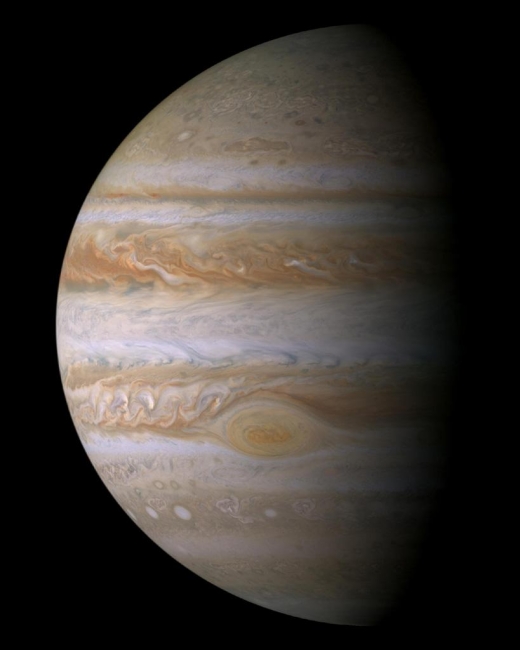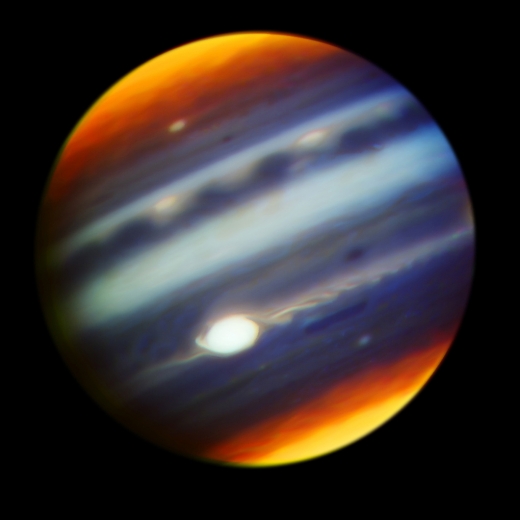I love the image of Jupiter below because of the detail — a mosaic of 27 images taken on closest approach by Cassini in 2000, it shows visible features down to 60 kilometers across. Nine images covering the entire planet were acquired in red, green and blue to provide color much like what our eyes would see if we were there. The Great Red Spot, nestled among the clouds of ammonia, hydrogen sulfide and water, is obvious. But we’ll soon learn much more, for the Juno spacecraft is scheduled to fly directly over the Great Red Spot on July 10.

Image: This true color mosaic of Jupiter was constructed from images taken by the narrow angle camera onboard NASA’s Cassini spacecraft on December 29, 2000, during its closest approach to the giant planet at a distance of approximately 10 million kilometers. Credit: NASA/JPL/Space Science Institute.
Launched on August 5, 2011, Juno completed its first year in Jupiter orbit on July 4, a reminder of how well shielded its instruments are in this tough environment. Rick Nybakken is project manager for Juno from JPL:
“The success of science collection at Jupiter is a testament to the dedication, creativity and technical abilities of the NASA-Juno team. Each new orbit brings us closer to the heart of Jupiter’s radiation belt, but so far the spacecraft has weathered the storm of electrons surrounding Jupiter better than we could have ever imagined.”
Indeed. Data collection from the Great Red Spot, a centuries-old, 16,000-kilometer wide storm, will be part of the spacecraft’s sixth science flyby, with perijove (the closest point in the orbit to Jupiter’s center) occurring on July 10 at 0955 EDT (1355 UTC). At this point, Juno will be about 3500 kilometers above the cloud tops. Less than 12 minutes later, the spacecraft will have moved directly above the huge storm, passing about 9000 kilometers above the Great Red Spot’s clouds, with all eight instruments as well as the JunoCam imager active.
Earth-based telescopes have provided continuing observations of Jupiter in coordination with Juno, and on May 18, 2017, both the Gemini North and Subaru telescopes (both on Mauna Kea) simultaneously studied the planet in high resolution at different wavelengths, helping to provide data on atmospheric dynamics at various depths at the Great Red Spot and other regions of Jupiter. The image below was taken at infrared wavelengths, where the Great Red Spot appears brightest and high-altitude clouds and hazes become strikingly evident.

Image: This composite, false-color infrared image of Jupiter reveals haze particles over a range of altitudes, as seen in reflected sunlight. It was taken using the Gemini North Telescope’s Near-InfraRed Imager (NIRI) on May 18, 2017, in collaboration with the investigation of Jupiter by NASA’s Juno mission. Juno completed its sixth close approach to Jupiter a few hours after this observation. Credit: Gemini Observatory/AURA/NASA/JPL-Caltech.
You can see a prominent wave pattern north of the equator, with two bright ovals that are anticyclones that appeared in January of this year. Both are evidently an indication of an upsurge in storm activity that has been observed in these latitudes in 2017. Another bright anticyclonic oval can be seen further north. And note the hook-like shape on the left side of the Great Red Spot, an indication of intense winds stretching out atmospheric features. More traces of this wave-like flow pattern can be seen sweeping off its eastern (right) side.
“Observations with Earth’s most powerful telescopes enhance the spacecraft’s planned observations by providing three types of additional context,” said Juno science team member Glenn Orton of NASA’s Jet Propulsion Laboratory, Pasadena, California. “We get spatial context from seeing the whole planet. We extend and fill in our temporal context from seeing features over a span of time. And we supplement with wavelengths not available from Juno. The combination of Earth-based and spacecraft observations is a powerful one-two punch in exploring Jupiter.”

Image: This false-color image of Jupiter was taken on May 18, 2017, with a mid-infrared filter centered at a wavelength of 8.8 microns, at the Subaru Telescope in Hawaii, in collaboration with observations of Jupiter by NASA’s Juno mission. The selected wavelength is sensitive to Jupiter’s tropospheric temperatures and the thickness of a cloud near the condensation level of ammonia gas. Credit: NAOJ/NASA/JPL-Caltech.



Perhaps this view of the GRS, can lead us to better theories on the
divergent behaviour of Gas Giants.
While solar winds/energy effects are to be expected on their atmospheres, it seems relatively minor and shallow compared to the whole of these planets.
Hopefully this mission will lead to upgrade theories as to why Jupiter and Saturn are so fairly different in their dynamics. It isn’t just gradual difference accounting for size. They are almost different species, to use a biological analogy. And the strange thing is, Neptune the smaller of the Jovians, has more in common with Jupiter than Saturn. Like Jupiter, Neptune has very strong winds, a very active atmosphere, a great dark spot.
Hopefully Juno can shed some light on these matters.
And Cassini too whose Grande Finale is in essence a watered down, speeded up “mini Juno” mission.
Would be very nice to finally see a modern day Cassini style “all rounder ” mission to one or both of the Ice Giants. Too much for a “New Frontiers” though. Given the plethora of transferable instrumentation coming out of recent and imminent solar system exploration, even a potent 150Kg payload “flagship” to Uranus has been conservatively costed at a ” reasonable” $2.4 billion with a further $400 million adding an atmospheric Probe too. Plus the substantial launch costs of SLS to provide a realistic transfer time.
It will be interesting to read about the new science that Juno acquires post the Galileo mission. We already have superb images of the pole for the first time, a view that we hadn’t seen before. Data about the interior masses will be a first. Information about Jupiter’s formation will be interesting, especially in regard to exoplanets and their formation.
Beautiful photos!
Speaking of giant alien planets in space…
Discovery of a Free-Floating Double Planet?
http://aasnova.org/2017/07/05/discovery-of-a-free-floating-double-planet/
and…
A cosmic barbecue: Researchers spot 60 new ‘hot Jupiter’ candidates
http://news.yale.edu/2017/07/06/cosmic-barbecue-researchers-spot-60-new-hot-jupiter-candidates
and…
Odd planetary system around fast-spinning star doesn’t quite fit existing models of planet formation
http://www.mpia.de/news/science/2017-08-hip65426
and…
The Milky Way galaxy could be home to 100 billion “failed” stars:
http://news.yorku.ca/2017/07/06/milky-way-could-be-home-to-100-billion-failed-stars/
If Jupiter could cover up the Great Red Spot it could probably cut down its utility bills by 20 or 30 percent.
Jupiter type worlds may have done much to give inner solar systems lots of water:
http://astrobiology.com/2017/07/origin-of-water-in-the-inner-solar-system.html
I’d love to see a long duration Jovian atmospheric probe. In upwelling areas you could do that with a robotic glider, or alternatively a hot hydrogen dirigible, with the heat provided by the same radioisotope generator that’s powering the probe.
The photos you’d get from down among the clouds would be remarkable, and you’d have a chance to actually sample the clouds. Who knows what we’d find there? Though probably not gigantic aerial lifeforms, like in Clark’s “A Meeting with Medusa”. Might be some bacteria, though.
Or these guys:
https://centauri-dreams.org/?p=6308
http://www.planetary.org/blogs/guest-blogs/2013/20131023-on-hunters-floaters-and-sinkers-from-cosmos.html
NASA’s Juno Probes the Depths of Jupiter’s Great Red Spot
https://www.jpl.nasa.gov/news/news.php?release=2017-316